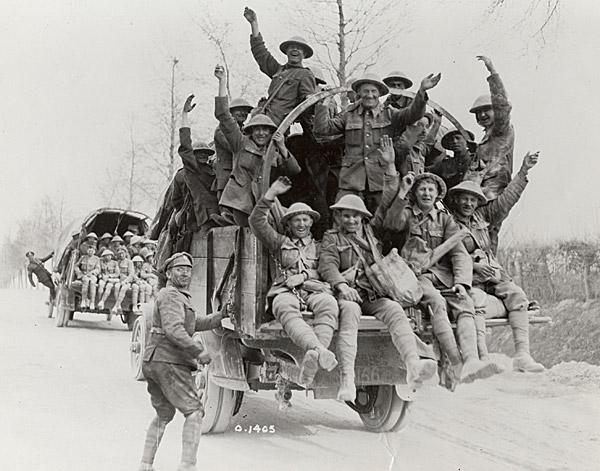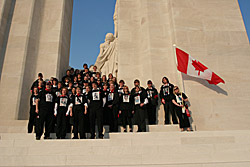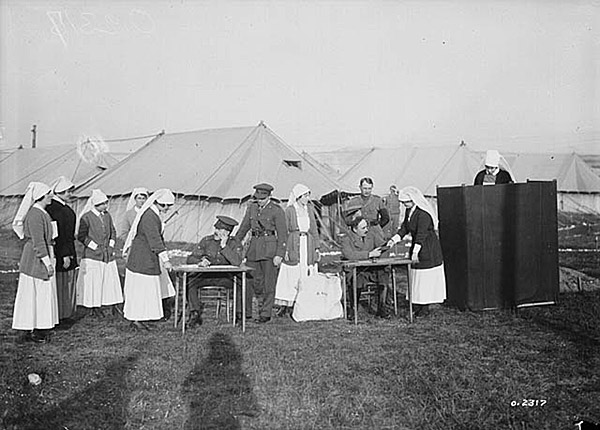Canada Remembers Times - 2007 Edition - Page 1
Download the PDF Version.
PDF Version 8.72 MB

Photo: Library and Archives Canada/PA-001332
In 1917, Canadians took part in a First World War battle that even 90 years later is a national point of pride. The scene was Vimy Ridge – a long, heavily defended hill along the Western Front in northern France. The British and French had tried unsuccessfully to capture it earlier in the war. On April 9, 1917, it was Canadas turn.
Early that morning, after months of planning and training, the first group of 20,000 Canadians attacked. Through the snow and sleet, Allied artillery laid down a "creeping barrage," an advancing line of precise shell fire. Canadian soldiers followed closely behind the explosions and overran the enemy before many of them could leave their underground bunkers. Most of the ridge was captured by noon that day, and the final part was taken on April 12. Canada had done it!
It has been said that Canada "came of age" as a country that day. Canadians from coast to coast fought side by side and achieved one of the greatest victories in our countrys history.
Mud and Death at Passchendaele

Photo: Library and Archives Canada/PA-002107
In the fall of 1917, Canadian troops in Belgium fought in the Third Battle of Ypres, better known as the Battle of Passchendaele.
The autumn rains came early that year to Flanders Fields. The fighting churned the flat terrain into a sea of muddy clay. Trenches filled with cold water and collapsed. Shell holes overflowed with muck. Men, equipment or horses that slipped off the "duckboards" (wooden walkways in trenches and on paths) were sucked into the swampy mess – often never to be seen again.
The Canadians joined the battle to help battered British forces, who had been fighting there since July. On October 26, Canadians began to advance on the enemy through often waist-deep mud. They were bombarded by German artillery and machine-gun fire. It was a nightmare of dirt and death. Finally, on November 6, 1917, Passchendaele was captured.
What was the cost to capture those few kilometers of land and the ruined remnants of the town? Almost 16,000 Canadian casualties. Nine Canadians earned the Victoria Cross for their valour during the battle.
Be Part of Bringing the Past to the Present

Youth from South Huron District High School in Exeter, ON, wearing t-shirts which honour the 41 young men from the same school who were killed in the First World War, Second World War, and the Korean War. Photo: Veterans Affairs Canada (VAC)
In April 2007, thousands of young Canadians travelled to France to mark the 90th Anniversary of the Battle of Vimy Ridge. Many youth researched a soldier who died in the battle and shared their soldiers life story during their visit to the Canadian National Vimy Memorial.
You can research the story of someone who gave their life serving Canada in times of war, military conflict or peace. The Canadian Virtual War Memorial is an on-line database with information about every Canadian who has died in military service. In some cases, photos, letters and other items of information have been added.
Diaries from the Front
Canadians serving far away from home turned to writing as a way of making sense of their experiences. Letters home, poetry and diaries helped them get through tough times.
An Air Battle
"This morning saw a grand duel between a British and a German squadron of planes… the fight centred around two machines, which were manoeuvring about each other like hostile eagles. Backwards and forwards over the breathless trenchlines they soared, each seeking to swoop upon the other from higher ground. Finally, "our man" got the advantage, opened his deadly machine-gun fire and sent his opponent blazing to the ground…
During the fight, all traffic had halted and the whole activity of war seemed to have stopped like a piece of clockwork. Now the wheels automatically started againteams trudged over the roads as before; men picked up their discarded rifles, or fell into step, or went back to dinners and cardgames; and the colonels climbed back into their dugouts."
Private Frank Walker,
(from Prince Edward Island)
Canadian Field Ambulance
The Somme, France
September 11, 1916
Nursing Sisters Help the Women's Right to Vote!

Photo: Library and Archives Canada/PA-002279
War has had a great effect on Canadian society. During the First World War, the role of women in public life evolved. The service of women as Nursing Sisters during the war, tending to the needs of sick and wounded soldiers overseas, lent power to the movement to give women the right to vote federally–something they had been denied until that time. In the general election of 1917, Nursing Sisters and women whose relatives were serving in the military were allowed to vote. The federal right to vote was extended to all Canadian women by 1918.
Did You Know?
Canadian soldiers risked life and limb in First World War trenches, but bombs and bullets werent the only dangers. "Trench foot" was also a major concern. After too many hours of standing in the muddy, wet trenches, blood circulation in soldiers feet slowed down. The result was a condition similar to frostbite. Many soldiers lost toes or entire feet.
Historical place names have been used in all instances. Veterans Affairs Canada recognizes that names and spellings of some countries/locations may have changed in recent times. However, for the sake of historical accuracy we have used the name and spellings used at the time of the event(s).
- Date modified: